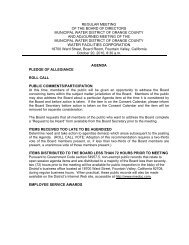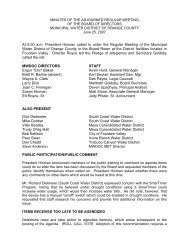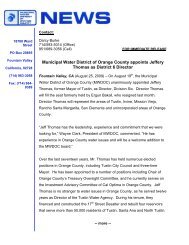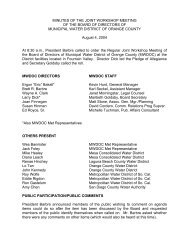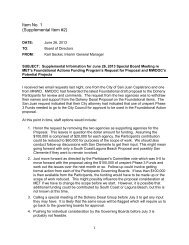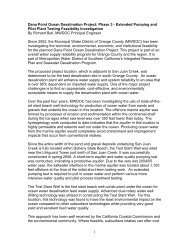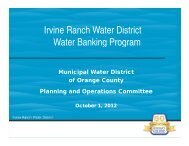UWM Plan - Municipal Water District of Orange County
UWM Plan - Municipal Water District of Orange County
UWM Plan - Municipal Water District of Orange County
You also want an ePaper? Increase the reach of your titles
YUMPU automatically turns print PDFs into web optimized ePapers that Google loves.
3.3.8. Recharge Facilities for OCWD Basin<br />
Section 3<br />
<strong>Water</strong> Sources and Supply Reliability<br />
Recharging water into the basin through natural and artificial means is essential to<br />
support pumping from the basin. Active recharge <strong>of</strong> groundwater began in 1949, in<br />
response to increasing drawdown <strong>of</strong> the basin and consequently the threat <strong>of</strong> seawater<br />
intrusion. In 1949, OCWD began purchasing imported Colorado River water from<br />
Metropolitan, which was delivered to <strong>Orange</strong> <strong>County</strong> via the Santa Ana River upstream<br />
<strong>of</strong> Prado Dam. The Basin’s primary source <strong>of</strong> recharge is flow from the Santa Ana River.<br />
OCWD diverts river flows into recharge basins located in and adjacent to the Santa Ana<br />
River and its main <strong>Orange</strong> <strong>County</strong> tributary, Santiago Creek. Other sources <strong>of</strong> recharge<br />
water include natural infiltration and recycled water. Today OCWD owns and operates a<br />
network <strong>of</strong> recharge facilities that cover 1,067 acres. The recharge capacity has exceeded<br />
10,000 AFY with the addition <strong>of</strong> the La Jolla Recharge Basin which came online in 2008.<br />
The La Jolla Recharge Basin is a 6-acre recharge basin.<br />
One <strong>of</strong> OCWD’s primary efforts has been the control <strong>of</strong> seawater intrusion into the<br />
Basin, especially via the Talbert and Alamitos seawater intrusion barriers. OCWD began<br />
addressing the Alamitos Gap intrusion by entering a partnership in 1965 with the Los<br />
Angeles <strong>County</strong> Flood Control <strong>District</strong> to operate injection wells in the Alamitos Gap.<br />
Operation <strong>of</strong> the injection wells forms a hydraulic barrier to seawater intrusion. To<br />
address seawater intrusion in the Talbert Gap, OCWD constructed <strong>Water</strong> Factory 21, a<br />
plant that treated secondary-treated water from the OCSD to produce purified water for<br />
injection. <strong>Water</strong> Factory 21 operated for approximately 30 years until it was taken <strong>of</strong>f<br />
line in 2004. It was replaced by an advanced water treatment system, the GWRS.<br />
The GWRS is a cooperative project between OCWD and OCSD that began operating in<br />
2008. Secondary-treated wastewater from OCSD undergoes treatment consisting <strong>of</strong><br />
micr<strong>of</strong>iltration, reverse osmosis, and advanced oxidation with ultraviolet light and<br />
hydrogen peroxide. It is the largest water purification project <strong>of</strong> its kind, Phase 1 <strong>of</strong> the<br />
GWRS began operating in 2008 with a capacity <strong>of</strong> purifying 72,000 AFY <strong>of</strong> water. The<br />
GWRS provides recharge water for the Talbert Injection Barrier as well as to recharge<br />
basins in the City <strong>of</strong> Anaheim. The Expanded Talbert Injection Barrier included 8 new<br />
injection wells which operation began in 2008. The GWRS increased reliable, local<br />
water supplies available for barrier injection from 5 MGD to 40 MGD.<br />
3.3.9. Metropolitan Groundwater Replenishment Program<br />
In an effort to maximize local resources, Metropolitan has partnered with the cities <strong>of</strong><br />
Anaheim, Fullerton, and Santa Ana, OCWD, and MWDOC and its member agencies who<br />
are groundwater producers in various programs to encourage the development <strong>of</strong> local<br />
resources. While MWDOC does not directly produce groundwater, it supports programs<br />
that maximize local resources to enhance reliability. OCWD, MWDOC, and<br />
Metropolitan have developed a successful and efficient groundwater replenishment<br />
program to increase storage in the <strong>Orange</strong> <strong>County</strong> Groundwater Basin. The Groundwater<br />
<strong>Municipal</strong> <strong>Water</strong> <strong>District</strong> <strong>of</strong> <strong>Orange</strong> <strong>County</strong><br />
2010 Regional Urban <strong>Water</strong> Management <strong>Plan</strong><br />
Final<br />
3-35



